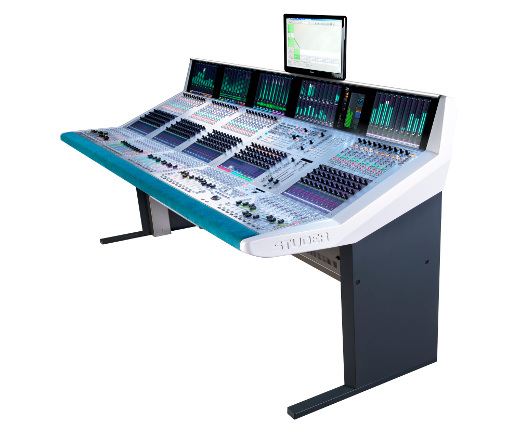Studer Introduces Vista X Console, with New Infinity Series Processing Engine
Studer is putting a stop to the power struggle.
The marquee manufacturer has just unveiled the new Vista X digital console and the Studer Infinity Processing engine, showing off their landmark new board in a well-attended NYC event that saw Meshell Ndegeocello onstage and the likes of Keith Shocklee in the audience.
A powerful entry in the large-scale mixing console market, the Vista X is aimed at users who can make full use of its intuitive user interface and Studer’s Vistonics and FaderGlow systems — providing control of 800 or more audio DSP channels and more than 5,000 inputs and outputs.
While broadcast is the stated market for the Vista X, we can also see it being desirable in scenarios where high track counts tally up, such as mixing, tracking and multi-media routing for orchestra halls.
The key to the Vista X’s capabilities are recent breakthroughs in CPU processing. Hopefully these big improvements in DSP, which we are now seeing at the top end of the market, will start to make its way down the line to other CPU-based audio systems in the near future.
Here’s more about what powers Vista X and the Infinity Processing Engine, direct from Studer:

(l) Sean Karpowicz of Harman’s Mixer Group, and Bomb Squad producer Keith Shocklee, were both in attendance.
At the heart of the system is the Infinity DSP core, which uses CPU-based processors to provide huge numbers of DSP channels for large-scale, high-resolution audio processing and mixing. Thanks to the Infinity core, this is the first time more than 800 audio channels have been processed in a single CPU-based board. This offers significant advantages, as CPU processing provides a scalable system, faster development of new signal processing designs, huge channel counts, full system redundancy without a single point of failure and the possibility of running third-party algorithms.
Until now, most audio DSP has used SHARC or FPGA chips. When applied to large-scale broadcast mixing applications these chip sets suffer two shortcomings: firstly, SHARC chips were developed nearly 15 years ago, and over time the capacity has increased by about 22 times. This has not kept pace with the increasing demands of modern multi-channel production. FPGAs, on the other hand, have increased in capacity hugely over the years but they are more complex to program for the specialist needs of audio DSP.
The impetus behind infinity was Studer’s desire to create a DSP engine that not only offers superb sonic quality but is adaptable and flexible to meet the changing demands of the market. The attraction of CPU technology as used on most computers has resulted in huge worldwide R&D investment in this technology. As such, these chips are not only extremely reliable in operation but also result in a doubling of processor power every 24 months (known as “Moore’s Law”).
The new Infinity DSP engine provides 12 A-Link high-capacity fiber digital audio interfaces, providing more than 5,000 inputs and outputs. A newly designed high-density I/O system – D23m, is used to break out these A-Link connections to standard analog, digital and video interfaces. The A-Link interface also provides direct connection to the Riedel MediorNet distributed router, allowing many Infinity systems to be connected together with router capacities of 10,000 square or more.
Studer consoles are designed with longevity and mission-critical operations in mind, and therefore reliability is of prime importance. A key element in the design of the Infinity Series is to avoid the possibility of a single fault causing loss of audio. Taking a lead from the “fly by wire” aircraft industry with multiple redundant processors flying the airplane, the new Vista X console features four processors, offering complete redundancy of the control surface. Now, the Infinity Core, with a combination of CPU-based DSP and A-Link audio interfaces, offers N+1 redundancy of the DSP engine and I/O with instant switchover between main and standby system without audio break.
CPU-based DSP means it is now economically viable to provide two completely independent DSP cores running in parallel with “instant” change over in case of DSP problems. The provision of two completely independent DSP engines overcomes potential single points of failure offered with traditional TDM-based systems. This new design also offers the possibility of two complete Vista X surfaces to be working on the same project at the same time. This allows very large, dual language or multi-format productions to be undertaken with ease.
Please note: When you buy products through links on this page, we may earn an affiliate commission.








